- Words by Tommy Watson
The initial call out to Atlas Trucks on their claimed I-Beam design didn’t spark the conversation that I thought it would. Atlas remained silent, where I’ve heard a lot from another truck company and now most recently and most thought out, from Lunar Boardworks. I’m excited to have the opportunity to expand upon the ideas behind our design and clarify some misconceptions that I’ve seen in regards to Skoa Stream 7s. Skoa trucks maintains that we are the only truck in the game to truly utilize an I-Beam design, that is, with flanges parallel to the ground, and the benefits that that utilization brings to our strength to weight ratio and resilience in most load scenarios experienced during skating with the Stream 7.
 If the Stream 7 utilizes an I-beam, how are a lot of the common style machined RKP (reverse kingpin) trucks like the Vapor actually different? They both appear to have cross sections that look like an I. In order to understand how orientation of a shape affects strength, we need to know how the components of an I-Beam work. An I-Beam is any beam with a cross section appearing in the shape of a capital I. The top and bottom horizontal elements are called “flanges” and the middle vertical element is called the “web”. The flanges resist bending forces (ones that may cause the material to flex), and the web resists shear forces (ones that may cause the parallel internal material surfaces to slide past one another. Think of plate-tectonics). I encourage you to read more about both of these forces, about I-Beams, and the theory behind their design to get a better understanding of what we’re talking about. I will tell you more as we go, so assuming you’re satisfied with what you know… in longboarding, we’re mostly dealing with bending forces when it comes to trucks.
If the Stream 7 utilizes an I-beam, how are a lot of the common style machined RKP (reverse kingpin) trucks like the Vapor actually different? They both appear to have cross sections that look like an I. In order to understand how orientation of a shape affects strength, we need to know how the components of an I-Beam work. An I-Beam is any beam with a cross section appearing in the shape of a capital I. The top and bottom horizontal elements are called “flanges” and the middle vertical element is called the “web”. The flanges resist bending forces (ones that may cause the material to flex), and the web resists shear forces (ones that may cause the parallel internal material surfaces to slide past one another. Think of plate-tectonics). I encourage you to read more about both of these forces, about I-Beams, and the theory behind their design to get a better understanding of what we’re talking about. I will tell you more as we go, so assuming you’re satisfied with what you know… in longboarding, we’re mostly dealing with bending forces when it comes to trucks.
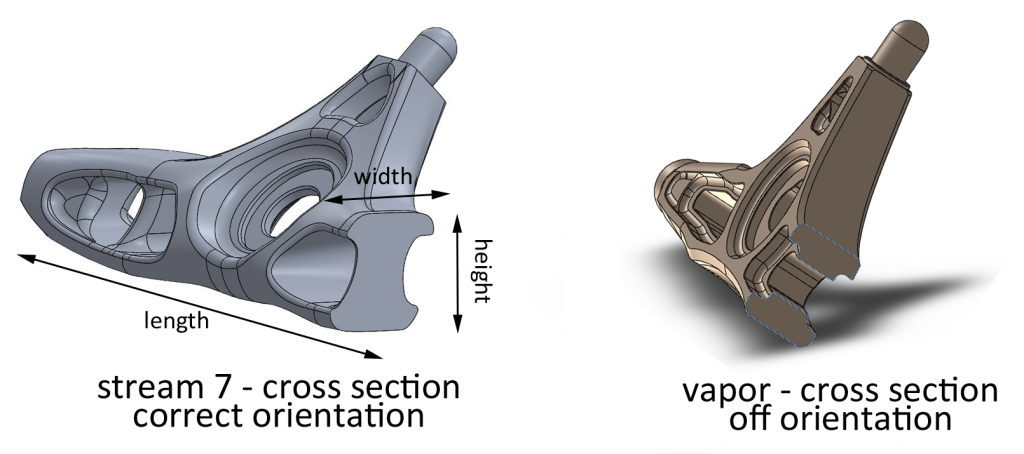 I-Beams are already a huge step forward in reducing weight in comparison to a solid beam. They’re great at supporting load across the length of the beam, and in structural design there are a few types of I-Beams. There’s your classic I-Beam that’s just an extrusion of that capital I cross section that I mentioned above and these are great, but can be made even lighter. To save weight, material is sometimes taken out from the web of the I-Beam. Some different types of I-Beams with this weight saving feature are “castellated” and “cellular” beams, differentiated from each other by the shape of the material removed.
I-Beams are already a huge step forward in reducing weight in comparison to a solid beam. They’re great at supporting load across the length of the beam, and in structural design there are a few types of I-Beams. There’s your classic I-Beam that’s just an extrusion of that capital I cross section that I mentioned above and these are great, but can be made even lighter. To save weight, material is sometimes taken out from the web of the I-Beam. Some different types of I-Beams with this weight saving feature are “castellated” and “cellular” beams, differentiated from each other by the shape of the material removed.
 When designing the Stream7, the cellular beam was a big influence over the shape that we created. In the Stream 7, this cellular “I-Beam” shape that we talk about runs the length of the truck (axle to axle) because the truck, the same as any beam, is designed to handle the load distributed across its length. This loading is experienced right when the board is put on the ground and is intensified when a rider stands on it. I’ll refer to this load scenario as scenario 1. We can simply look at this scenario to illustrate how shape and orientation of a beam affect its strength.
When designing the Stream7, the cellular beam was a big influence over the shape that we created. In the Stream 7, this cellular “I-Beam” shape that we talk about runs the length of the truck (axle to axle) because the truck, the same as any beam, is designed to handle the load distributed across its length. This loading is experienced right when the board is put on the ground and is intensified when a rider stands on it. I’ll refer to this load scenario as scenario 1. We can simply look at this scenario to illustrate how shape and orientation of a beam affect its strength.
Below we have our FEA simulations on 90mm beams (about half the length of most trucks). These beams are made of a given material in different shapes and different orientations, fixed on one side with a force applied to the other. The force applied is an arbitrary amount of 1500 Newtons just to give us values of deflection. This force was applied 18mm from the end of the beam to simulate an axle and the bearings/spacer in a wheel. Of course, there’s more forces that act on a truck while you’re skating and the exact angle that a force interacts with the hanger at will depend on the angle of the baseplate it’s mounted on, the object applying the force, size of wheels… a whole lot of stuff. We’re simplifying all of that for simulation’s sake. Using these simulations, we will show how orientation as well as shape affect strength and weight.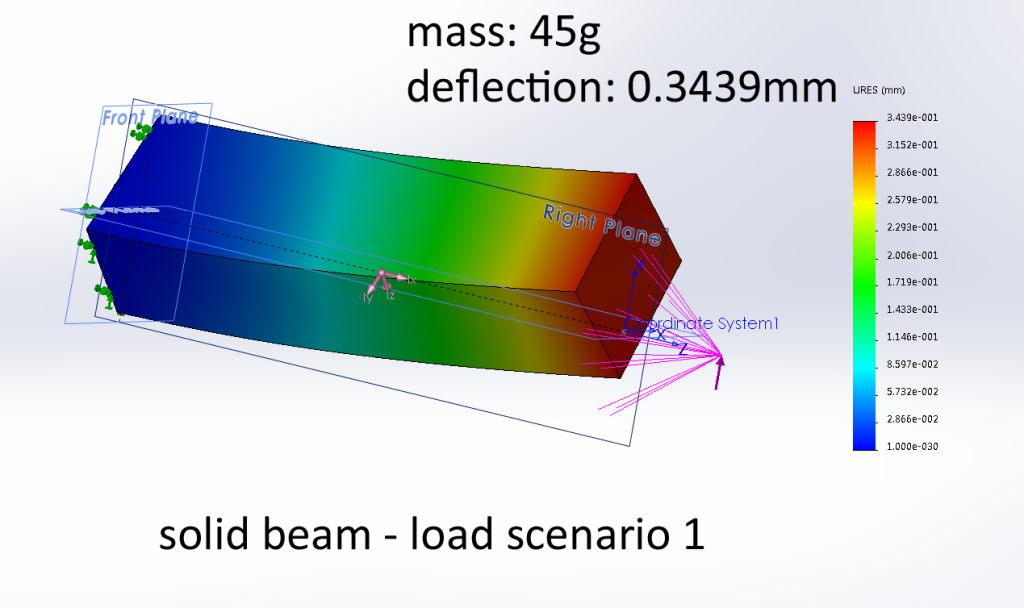
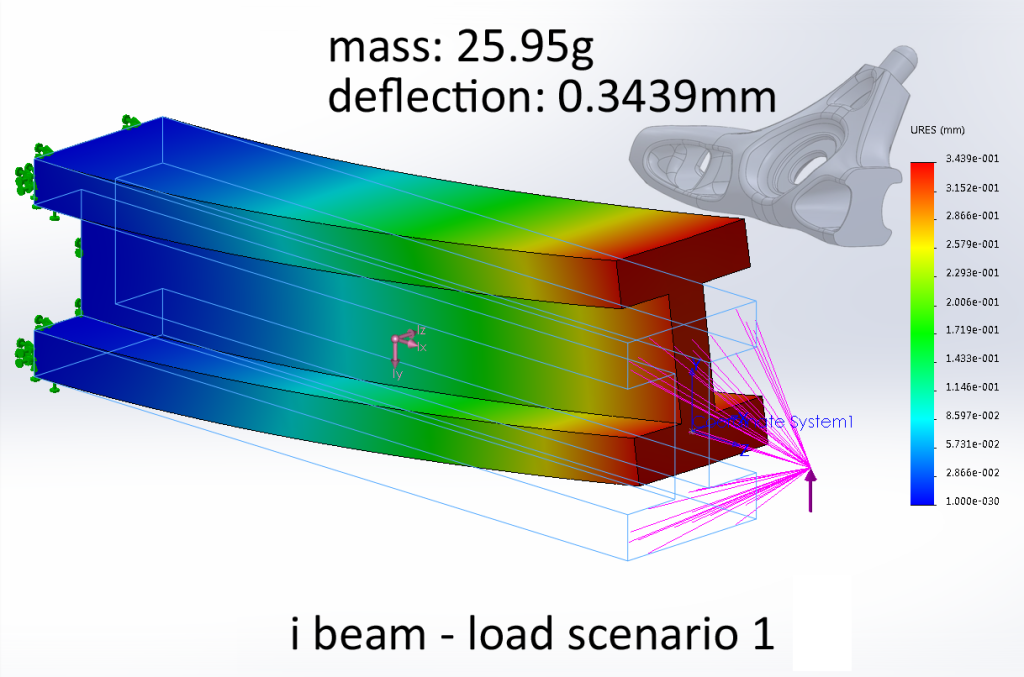
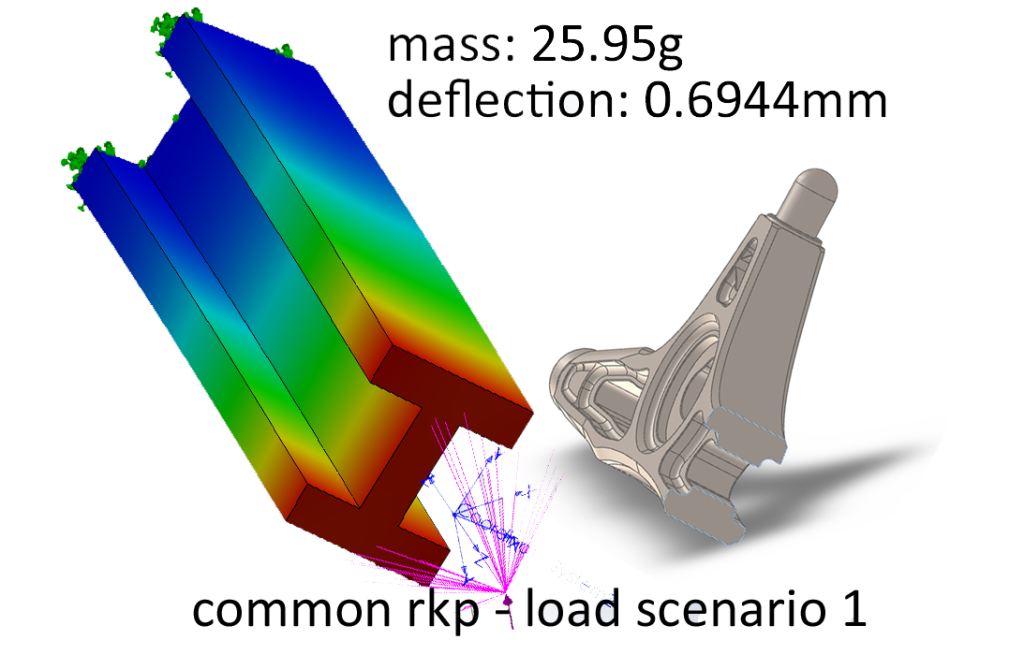 As you can see in the simulations above, the orientation and shape play a huge role in how the beam will handle the loads applied to it. Most beams have a strong axis of bending and a weak axis of bending. We’ll define these axis below:
As you can see in the simulations above, the orientation and shape play a huge role in how the beam will handle the loads applied to it. Most beams have a strong axis of bending and a weak axis of bending. We’ll define these axis below:
 The I-Beam shape is great at handling loads across it’s length, as illustrated by the man on the right, and worse at handling loads across it’s height, as illustrated by the woman on the left. From our simulations, the I-Beam and Common weight-reduced RKP are roughly 42% lighter than the solid beam, yet the I-Beam in the correct orientation deflects the same amount while the common machined RKP exhibits over twice the deflection!
The I-Beam shape is great at handling loads across it’s length, as illustrated by the man on the right, and worse at handling loads across it’s height, as illustrated by the woman on the left. From our simulations, the I-Beam and Common weight-reduced RKP are roughly 42% lighter than the solid beam, yet the I-Beam in the correct orientation deflects the same amount while the common machined RKP exhibits over twice the deflection!
In designing the Stream 7, we based our simulations off forces like the ones above, as well as from other angles that could be caused from running over debris, cracks, etc. Our flanges are quite wide and according to our simulations, we did not need much material at all between the axle housing and bushing seat areas to achieve the strength/weight characteristics we wanted in our truck. With this knowledge, we chose to have the minimal amount of webbing that we have between the flanges. Our simulations of the strength of the Stream 7 have proven to be correct over the last 3 years that the Stream 7 has been out, with bending only being reported in extreme circumstances, such as a board being run over by a vehicle.
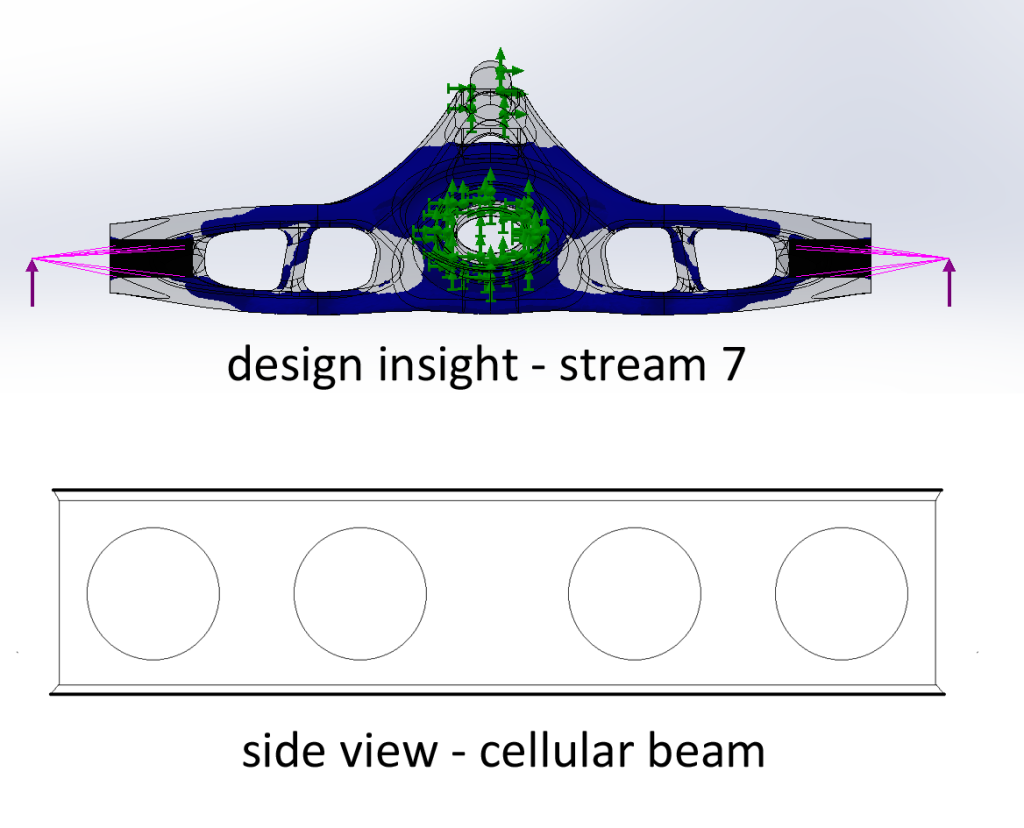 Certainly, both orientations of this shape work for skateboarding. We have all used trucks designed in the common style and it’s the common style for a reason. It’s effective enough and much easier to produce! Easier production lowers the cost of the end product to the rider which is certainly a something to consider when making a purchase. Common weight-reduced RKP trucks like the Vapor can still be light and strong, but the orientation of their flanges is not optimal for the forces that they experience. Stream 7s are the first truck out there to have the optimized orientation and fully utilize the benefits of the I-Beam shape. You don’t see I-Beams installed in buildings at an angle because it’s not effective. “Nonnovation” is taking something that’s been done forever, naming it, and calling it a feature. 90* baseplates are the solution for the common truck if you want to get the most strength out of that shape… but until someone does that (which would not feel good to skate on), Stream 7s are the only trucks that can lay claim to the I-Beam in our opinion.
Certainly, both orientations of this shape work for skateboarding. We have all used trucks designed in the common style and it’s the common style for a reason. It’s effective enough and much easier to produce! Easier production lowers the cost of the end product to the rider which is certainly a something to consider when making a purchase. Common weight-reduced RKP trucks like the Vapor can still be light and strong, but the orientation of their flanges is not optimal for the forces that they experience. Stream 7s are the first truck out there to have the optimized orientation and fully utilize the benefits of the I-Beam shape. You don’t see I-Beams installed in buildings at an angle because it’s not effective. “Nonnovation” is taking something that’s been done forever, naming it, and calling it a feature. 90* baseplates are the solution for the common truck if you want to get the most strength out of that shape… but until someone does that (which would not feel good to skate on), Stream 7s are the only trucks that can lay claim to the I-Beam in our opinion.